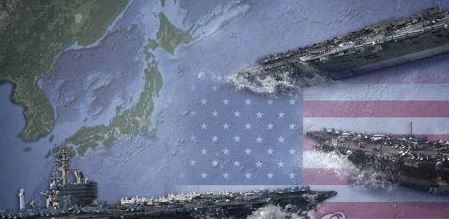Korean warships train with three US aircraft carriers in East Sea
By YonhapPublished : Nov. 12, 2017 - 15:09
Three US aircraft carriers joined an ongoing exercise with the South Korean Navy in the East Sea on Sunday in an unprecedented show of force against a provocative North Korea.
The three flattops -- USS Ronald Reagan, USS Nimitz and USS Theodore Roosevelt -- entered the South's military operation zone, called the Korea Theater of Operations, for the four-day maneuvers slated to end Tuesday.
It marks the first time that the country's Navy has conducted a combined training with three US aircraft carriers.
The three flattops -- USS Ronald Reagan, USS Nimitz and USS Theodore Roosevelt -- entered the South's military operation zone, called the Korea Theater of Operations, for the four-day maneuvers slated to end Tuesday.
It marks the first time that the country's Navy has conducted a combined training with three US aircraft carriers.

The carriers steamed in formation followed by a dozen warships, including South Korea's two Aegis destroyers -- the Sejong the Great and the Seoae Yu Seong-ryong -- according to a video clip recorded and released by the South Korean Navy.
"The South Korean and US navies are maintaining a perfect defense posture to carry out combined operations anytime and anywhere," said Capt. Lee Ku-seong, captain of the Sejong the Great ship. "On the basis of our robust alliance, (we) will deter the enemy's provocations."
The tri-carrier operation is highly unusual. The United States' previous exercise involving three carriers took place in waters near Guam in the Western Pacific a decade ago.
Seoul's Joint Chiefs of Staff said that the allies' naval exercise this time is aimed at enhancing the credibility of "extended deterrence" against the North's nuclear and missile provocations. Extended deterrence refers to the US commitment to defend its ally by mobilizing all military capabilities, nuclear and conventional, against the North's aggression.
"The combined drills are to present our resolve and will to deter North Korea's provocations and retaliate if provoked," a South Korean defense official said, requesting anonymity.
The exercise comes after the two countries agreed in talks between their respective defense ministers last month to expand the rotational deployment of US strategic military assets to the Korean Peninsula to better cope with North Korean provocations.
Seoul and Washington have recently carried out a series of drills to show off their military heft in response to the North's saber-rattling, such as its sixth and most powerful nuclear test on Sept. 3 and a series of missile launches.
American leaders, including President Donald Trump, have warned the belligerent regime not to "underestimate" or "test" US strength. (Yonhap)







![[Graphic News] More Koreans say they plan long-distance trips this year](http://res.heraldm.com/phpwas/restmb_idxmake.php?idx=644&simg=/content/image/2024/04/17/20240417050828_0.gif&u=)
![[KH Explains] Hyundai's full hybrid edge to pay off amid slow transition to pure EVs](http://res.heraldm.com/phpwas/restmb_idxmake.php?idx=644&simg=/content/image/2024/04/18/20240418050645_0.jpg&u=20240419100350)






![[From the Scene] Monks, Buddhists hail return of remains of Buddhas](http://res.heraldm.com/phpwas/restmb_idxmake.php?idx=652&simg=/content/image/2024/04/19/20240419050617_0.jpg&u=20240419175937)

![[KH Explains] Hyundai's full hybrid edge to pay off amid slow transition to pure EVs](http://res.heraldm.com/phpwas/restmb_idxmake.php?idx=652&simg=/content/image/2024/04/18/20240418050645_0.jpg&u=20240419100350)

![[Today’s K-pop] Illit drops debut single remix](http://res.heraldm.com/phpwas/restmb_idxmake.php?idx=642&simg=/content/image/2024/04/19/20240419050612_0.jpg&u=)